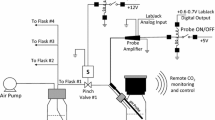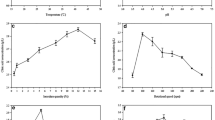Abstract
Owing to its toxicity, aluminum (Al), which is one of the most abundant metals, inhibits the productivity of many cultures and affects the microbial metabolism. The aim of this work was to investigate the capacity of sugar cane vinasse to mitigate the adverse effects of Al on cell growth, viability, and budding, as the likely result of possible chelating action. For this purpose, Fleischmann’s yeast (Saccharomyces cerevisiae) was used in growth tests performed in 125-mL Erlenmeyer flasks containing 30 mL of YED medium (5.0 g/L yeast extract plus 20 g/L glucose) supplemented with the selected amounts of either vinasse or Al in the form of AlCl3 · H2O. Without vinasse, the addition of increasing levels of Al up to 54 mg/L reduced the specific growth rate by 18%, whereas no significant reduction was observed in its presence. The toxic effect of Al on S. cerevisiae growth and the mitigating effect of sugar cane vinasse were quantified by the exponential model of Ciftci et al. (Biotechnol Bioeng 25:2007–2023, 1983). The cell viability decreased from 97.7% at the start to 84.0% at the end of runs without vinasse and to 92.3% with vinasse. On the other hand, the cell budding increased from 7.62% at the start to 8.84% at the end of runs without vinasse and to 17.8% with vinasse. These results demonstrate the ability of this raw material to stimulate cell growth and mitigate the toxic effect of Al.




Similar content being viewed by others
References
Aranda JS, Salgado E, Taillandier P (2004) Trehalose accumulation in Saccharomyces cerevisiae cells: experimental data and structured modelling. Biochem Eng J 17:129–140. doi:10.1016/S1369-703X(03)00148-7
Arieff AI (1990) Aluminum and the pathogenesis of dialysis dementia. Environ Geochem Health 12:89–93
Assmann S, Sigler K, Höfer M (1996) Cd2+ induced damage to yeast plasma membrane and its alleviation by Zn2+: studies on Schizosaccharomyces pombe and reconstituted plasma membrane vesicles. Arch Microbiol 165:279–284. doi:10.1007/s002030050327
Bagy MMK, El-Sharouny HMM, Elshanawany AA (1991) Effect of pH and organic matter on toxicity of heavy metals to growth of some fungi. Folia Microbiol 36:367–374. doi:10.1007/BF02814511
Baker JP, Schofield CL (1982) Aluminum toxicity to fish in acidic waters. Water Air Soil Pollut 18:289–309. doi:10.1007/BF02419419
Bonneu M, Crouzet M, Urdaci M, Aigle M (1991) Direct selection of yeast mutants with reduced viability on plates by erythrosine B staining. Anal Biochem 193:225–230. doi:10.1016/0003-2697(91)90013-J
Ciftci C, Constantinides A, Wang SS (1983) Optimization of conditions and cell feeding procedures for alcohol fermentation. Biotechnol Bioeng 25:2007–2023. doi:10.1002/bit.260250811
Converti A, Perego P, Del Borghi M, Parisi F, Ferraiolo G (1986) Kinetic considerations about the study of alcoholic fermentations of starch hydrolysate. Biotechnol Bioeng 28:711–717. doi:10.1002/bit.260280510
Date RA, Holliday J (1979) Selecting Rhizobium for acid, infertile soils of the tropics. Nature 277:62–64. doi:10.1038/277062a0
De Faveri D, Torre P, Aliakbarian B et al (2008) Conversión microbiana de ácido ferúlico a vainillina. In: Bustos Vázquez G, Velázquez de la Cruz G, Rangel Torres E, Compeán Ramírez E, Campos Leal JR et al (eds) Aprovechamiento biotecnológico de productos agropecuarios II. Plaza y Valdés. S.A. de C.V, Mexico, pp 181–203
de Vries W, van der Salm C, Reinds GJ, Erisman JW (2007) Element fluxes through European forest ecosystems and their relationships with stand and site characteristics. Environ Pollut 148:501–513. doi:10.1016/j.envpol.2006.12.001
Driscoll CT, Lawrence GB, Bulger AJ et al (2001) Acidic deposition in the Northeastern United States: sources and inputs, ecosystem effects, and management strategies. Bioscience 51:180–198. doi:10.1641/0006-3568(2001)051[0180:ADITNU]2.0.CO;2
Exley C, Price NC, Birchall JD (1994) Aluminum inhibition of hexokinase activity in vitro: a study in biological availability. J Inorg Biochem 54:297–304. doi:10.1016/0162-0134(94)80035-9
Ezaki B, Sivaguru M, Ezaki Y, Matsumoto H, Gardner RC (1999) Acquisition of aluminum tolerance in Saccharomyces cerevisiae by expression of the BCB or NtGDI1 gene derived from plants. FEMS Microbiol Lett 171:81–87. doi:10.1111/j.1574-6968.1999.tb13415.x
Finder VH, Glockshuber R (2007) Amyloid-β aggregation. Neurodegen Dis 4:13–27. doi:10.1159/000100355
Foy CD, Gerloff GC (1972) Response of Chlorella pyrenoidosa to aluminum and low pH. J Phycol 8:268–271
Gensemer RW, Playle RC (1999) The bioavailability and toxicity of aluminum in aquatic environments. Crit Rev Environ Sci Technol 29:315–450. doi:10.1080/10643389991259245
Guida L, Saidi Z, Hugues MN, Poole RK (1991) Aluminum toxicity and binding to Escherichia coli. Arch Microbiol 156:507–512
Haug A (1984) Molecular aspects of aluminum toxicity. Crit Rev Plant Sci 1:345–373. doi:10.1080/07352688409382184
Haug AR, Vitorello V (1997) Cellular aspects of aluminum toxicity in plants. In: Yafui M, Strong MJ, Ota K, Verity MA (eds) Mineral and metal neurotoxicology. CRC Press, New York, pp 35–41
Houeland T (1990) Aluminum and Alzheimer’s disease: is there a causal connection? Environ Geochem Health 12:173–178. doi:10.1007/BF01734066
Jongbloed RH, Borstpauwels GWFH (1992) Effects of aluminum and pH on growth and potassium uptake by 3 ectomycorrhizal fungi in liquid culture. Plant Soil 140:157–165. doi:10.1007/BF00010593
Kinraide TB (2003) Toxicity factors in acidic forest soils: attempts to evaluate separately the toxic effects of excessive Al3+ and H+ and insufficient Ca2+ and Mg2+ upon root elongation. Eur J Soil Sci 54:323–333. doi:10.1046/j.1365-2389.2003.00538.x
Klimashevskii EL, Chernysheva NF (1980) Content of organic acids and physiologically active compounds in plants differing in their susceptibility to the toxicity of Al+3. Sovietic Agric Sci 2:5–7
Kochian LV (1995) Cellular mechanisms of aluminum toxicity and resistance in plants. Annu Rev Plant Physiol Plant Mol Biol 46:237–260. doi:10.1146/annurev.pp.46.060195.001321
Liu G, Huang W, Moir RD et al (2006) Metal exposure and Alzheimer’s pathogenesis. J Struct Biol 155:45–51. doi:10.1016/j.jsb.2005.12.011
MacDiarmid CW, Gardner RC (1996) Al toxicity in yeast. Plant Physiol 112:1101–1109. doi:10.1104/pp.112.3.1101
MacDiarmid CW, Gardner RC (1998) Overexpression of the Saccharomyces cerevisiae magnesium transport system confers resistance to aluminum ion. J Biol Chem 273:1727–1732. doi:10.1074/jbc.273.3.1727
Mariano-Da-Silva S, Basso LC (2004) Effect of cadmium on the growth of two Saccharomyces cerevisiae strains, and the vinasse capacity to attenuate the toxicity. Ciênc Tecnol Aliment 24:16–22
Norris PR, Kelly DP (1977) Accumulation of cadmium and cobalt by Saccharomyces cerevisiae. J Gen Microbiol 99:317–324
Parnaudeau V, Condom N, Oliver R, Cazevieille P, Recous S (2008) Vinasse organic matter quality and mineralization potential, as influenced by raw material, fermentation and concentration processes. Bioresource Technol 99:1553–1562. doi:10.1016/j.biortech.2007.04.012
Poschenrieder C, Gunsé B, Corrales I, Barceló J (2008) A glance into aluminum toxicity and resistance in plants. Sci Total Environ 400:356–368. doi:10.1016/j.scitotenv.2008.06.003
Prado-Filho LG, Domingos RN, Silva SMG (1998) Acúmulo de cádmio por Saccharomyces cerevisiae fermentando mosto de melaço. Sci Agric 55:128–132
Rao KSJ, Easwaran KRK (1997) Al-27-NMR studies of aluminum transport across yeast cell membranes. Mol Cell Biochem 175:59–63. doi:10.1023/A:1006885228074
Rodríguez-Porrata B, Novo M, Guillamón J, Rozès N, Mas A, Cordero Otero R (2008) Vitality enhancement of the rehydrated active dry wine yeast. Int J Food Microbiol 126:116–122. doi:10.1016/j.ijfoodmicro.2008.05.016
Schott EJ, Gardner RD (1997) Aluminum-sensitive mutants of Saccharomyces cerevisiae. Mol Gen Genet 254:63–72. doi:10.1007/s004380050391
Sokal RR, Rohlf FJ (1979) Biometría. principios y métodos estadísticos en la investigación biológica. H, Blume, Madrid
Stupiello JP (1987) A cana-de-açúcar como matéria-prima. In: Paranhos SB (ed) Cana-de-açúcar: Cultivo e utilização, vol 2. Fundação Cargill, São Paulo, pp 761–804
Suhayda CG, Haug A (1986) Organic acid reduce aluminum toxicity in maize root membranes. Physiol Plantarum 68:189–195. doi:10.1111/j.1399-3054.1986.tb01913.x
Thevelein JM (1984) Regulation of trehalose mobilization in fungi. Microbiol Rev 48:42–59
Womack FC, Colowick SP (1979) Proton-dependent inhibition of yeast and brain hexokinases by aluminum in ATP preparations. Proc Natl Acad Sci USA 76:5080–5084. doi:10.1073/pnas.76.10.5080
Yang JL, You JF, Li YY, Wu P, Zheng SJ (2007) Magnesium enhances aluminum-induced citrate secretion in rice bean roots (Vigna umbellata) by restoring plasma membrane H+-ATPase activity. Plant Cell Physiol 48:66–73. doi:10.1093/pcp/pcl038
Yoshino M, Murakami K, Kawano K (1998) Interaction of aluminum ion with ATP. Mechanism of the aluminum inhibition of glycerol kinase and its reversal by spermine. Biometals 11:63–67. doi:10.1023/A:1009213508942
Zel J, Svetek J, Crne H, Schara M (1993) Effects of aluminum on membrane fluidity of the mycorrhizal fungus Amanita muscaria. Physiol Plantarum 89:172–176. doi:10.1111/j.1399-3054.1993.tb01801.x
Acknowledgment
The financial contribution by the PIBIC (Programa Institucional de Bolsas de Iniciação Científica) of Brazilian CNPq is gratefully acknowledged.
Author information
Authors and Affiliations
Corresponding author
Rights and permissions
About this article
Cite this article
de Souza Oliveira, R.P., Rivas Torres, B., Zilli, M. et al. Use of Sugar Cane Vinasse to Mitigate Aluminum Toxicity to Saccharomyces cerevisiae . Arch Environ Contam Toxicol 57, 488–494 (2009). https://doi.org/10.1007/s00244-009-9287-x
Received:
Accepted:
Published:
Issue Date:
DOI: https://doi.org/10.1007/s00244-009-9287-x




